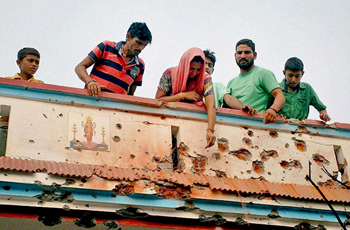Jammu, Oct 8: Two women of a family were today killed and 15 others injured in heavy mortar shelling and firing by Pakistani troops along the international border in Jammu and Kashmir, taking the death toll to eight in the continued ceasefire violations by Pakistan for over a week.
 Pakistani Rangers targeted 50 border out posts (BoPs) and 35 hamlets overnight along the 192-km boundary. The escalation has triggered an exodus, with 16,000 people moving to safer areas from border villages.
Pakistani Rangers targeted 50 border out posts (BoPs) and 35 hamlets overnight along the 192-km boundary. The escalation has triggered an exodus, with 16,000 people moving to safer areas from border villages.
Over 70 people have been injured in the ceasefire violations by Pakistan, including 15 today.
Pakistani Rangers target Chillary village along IB in Samba district around 0730 hours today. In the mortar shelling, Shukuntla Devi and her daughter-in-law Poli Devi were killed while their husbands along with two children of Poli were injured, Senior Superintendent of Police (SSP), Samba, Anil Mangotra said.
All the inhabitants of village with a population 1,700 have fled from border hamlet to safety.
Along the Line of Control (LoC), the firing stopped last night in Mendhar & Poonch sectors after Indian forces gave a befitting reply, defence officials said.
Among the 15 injured today, three were BSF jawans. All of them have been shifted to Government Medical College (GMC) hospital, the SSP said.
Jorda Farm border hamlet was hit by shelling at 0900 hrs, police officials said. Six persons were injured when they were returning after night stay in shelter camp in R S Pura. They were shifted to GMC hospital for treatment, they said.
Earlier, a BSF spokesman today said that "Pakistani Rangers again resorted to unprovoked mortar shelling and heavy firing on BSF posts all along IB since 2000 hours last night."
As many as 50 BSF BoPs were affected by the fire from Pakistan side, he said, adding areas along IB in Arnia, R S Pura, Kanachak and Pargwal sub-sectors in Jammu and Samba districts were targeted.
Eight people have been killed and 71 others including BSF jawans injured in Pakistani shelling and firing along LoC and IB in Jammu and Poonch districts in over two dozen ceasefire violations since October 1 this year.
On Monday, Pakistani troops violated ceasefire by resorting to heavy firing and shelling in Arnia belt along IB in Jammu in which 5 people were killed and 34 injured.
On October 3, Pakistani troops violated ceasefire in Gulamarg sector of Kashmir Valley and in Poonch and Jammu sectors in which a girl was killed and six persons were injured.
There have been nine ceasefire violations along the LoC and eight along the IB in Jammu. These include seven in Poonch along LoC, eight along International Border in Jammu and two in Gulmarg sector of Kashmir.
Six persons have been killed and 50 others including BSF jawan injured in Pakistani shelling and firing along LoC and IB in Jammu and Poonch districts in the ceasefire violations this month.
On October 6, Pakistan had violated the ceasefire thrice in Bhimber Gali, Kerni and Balakote-Mankote in Poonch district.
On October 5, there were two ceasefire violations. Pakistani troops violated the ceasefire by resorting to heavy firing and shelling in Arnia belt along IB in Jammu in which five persons were killed and 34 others were injured.
There was another ceasefire violation during the day when Pakistani troops targeted forward India posts along LoC in Balnoie sub-sector of Poonch district.
On October 4, Pakistani troops resorted to heavy firing and mortar shelling along LoC in in Poonch district of Jammu and Kashmir, drawing equal retaliation from the Army.
Pakistani Rangers violated the ceasefire four times on October 3 by shelling forward areas and villages along LoC and International Border in Gulamarg sector of Kashmir Valley and Poonch and Jammu sector in which a girl was killed and six persons were injured.
On October 1 and 2, Pakistani troops had violated the ceasefire twice along the LoC in Poonch district resulting in injuries to six persons.
Pakistani troops had targeted civilian hamlets on October two, leaving six persons injured.
Protest demonstrations, meanwhile, continued in Jammu for the second consecutive day today against the ceasefire violations by Pakistan.
The Youth wing of the Nationalist Congress Party held a protest demonstration against the violation.
BJP workers also held protest demonstrations against the firing at Manyari border belt of Samba district.






Comments
Add new comment